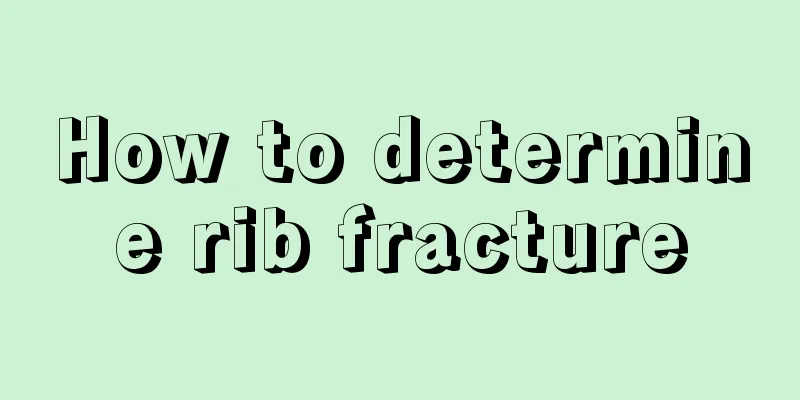How to determine rib fracture

|
When it comes to fractures, many people are familiar with them. Fractures cause great harm to the body, and the treatments for different groups of people are different. For young people with fractures, some conservative treatments can be chosen, and older people can choose surgical treatments. So how to judge rib fractures? The judgment of this type of fracture can be made based on the symptoms and causes of the patient's own symptoms, so that a correct judgment can be made. Rib fractures mostly occur at the 4th to 7th ribs; the 1st to 3rd ribs are protected by the clavicle, scapula and shoulder girdle muscles and are not easily fractured; the 8th to 10th ribs gradually become shorter and are connected to the cartilage costal arch, which has elastic cushioning and reduces the chance of fracture; the 11th and 12th ribs are floating ribs with a greater range of motion and rarely fracture, but when the force is strong, these ribs may fracture. Rib fractures usually occur at ribs 4 to 7; ribs 1 to 3 have clavicles A fracture of only one rib is called a single rib fracture, and fractures of two or more ribs are called multiple rib fractures. Rib fractures can occur on both sides of the chest at the same time. A fracture in only one place on each rib is called a single fracture, and a fracture in two or more places is called a double or multiple fracture. Sequential fractures of multiple ribs or multiple rib fractures combined with epiphyseal detachment of multiple costal cartilages or fractures of multiple costal cartilages on both sides or epiphyseal detachment will cause chest wall softening, which is called a floating chest wall injury, also known as flail chest. Local pain is the most obvious symptom of rib fracture, and it worsens with movements such as coughing, deep breathing or body turning. Sometimes the patient can also hear or feel a "clicking" sensation of bone friction at the fractured rib. Pain and destruction of chest stability can limit respiratory mobility, cause shallow and rapid breathing and reduce alveolar ventilation. The patient dare not cough, sputum retention, which causes obstruction of lower respiratory tract secretions, pulmonary dampness or atelectasis. This should be paid special attention to in the elderly and weak patients or those with existing lung diseases. In flail chest, when inhaling, the negative pressure in the chest cavity increases, and the softened part of the chest wall sinks inward; when exhaling, the chest cavity pressure increases, and the damaged chest wall floats and bulges, which is opposite to the movement of other chest walls and is called "abnormal respiratory movement." Abnormal breathing movements can cause an imbalance in the pressure of the chest cavities on both sides. The mediastinum moves back and forth with breathing, which is called "mediastinal swing", affecting blood return and causing circulatory dysfunction. It is one of the important factors leading to and aggravating shock. Chest pain and destruction of chest stability are more serious in flail chest. Abnormal breathing movements further limit respiratory movements, make coughing weak, reduce vital capacity and functional residual capacity (FRC), and reduce lung compliance and tidal volume, often accompanied by severe dyspnea and hypoxemia. In the past, it was believed that during flail chest, some gas flows back and forth between the healthy and injured lungs with inhalation and exhalation and cannot be exchanged with the atmosphere. This is called residual gas convection or swinging gas, and is the main cause of respiratory dysfunction. However, it is currently believed that swinging gas does not exist. The pulmonary contusion that often accompanies flail chest can cause alveolar and interstitial bleeding, edema, alveolar rupture and atelectasis, and is an important cause of respiratory dysfunction. Occasionally, due to severe coughing or sneezing, the chest muscles suddenly contract and cause rib fractures, which are called spontaneous rib fractures. They mostly occur in the 6th to 9th ribs in the axillary area. When the ribs themselves have lesions, such as primary tumors or metastatic tumors, rib fractures may also occur with very light external force or no external force. This is called pathological rib fractures. Rib fractures mostly occur at the 4th to 7th ribs; the 1st to 3rd ribs are protected by the clavicle, scapula and shoulder girdle muscles and are not easily fractured; the 8th to 10th ribs gradually become shorter and are connected to the cartilage costal arch, which has elastic cushioning and reduces the chance of fracture; the 11th and 12th ribs are floating ribs with a greater range of motion and rarely fracture, but when the force is strong, these ribs may fracture. Rib fractures usually occur at ribs 4 to 7; ribs 1 to 3 have clavicles A fracture of only one rib is called a single rib fracture, and fractures of two or more ribs are called multiple rib fractures. Rib fractures can occur on both sides of the chest at the same time. A fracture in only one place on each rib is called a single fracture, and a fracture in two or more places is called a double or multiple fracture. Sequential fractures of multiple ribs or multiple rib fractures combined with epiphyseal detachment of multiple costal cartilages or fractures of multiple costal cartilages on both sides or epiphyseal detachment will cause chest wall softening, which is called a floating chest wall injury, also known as flail chest. Local pain is the most obvious symptom of rib fracture, and it worsens with movements such as coughing, deep breathing or body turning. Sometimes the patient can also hear or feel a "clicking" sensation of bone friction at the fractured rib. Pain and destruction of chest stability can limit respiratory mobility, cause shallow and rapid breathing and reduce alveolar ventilation. The patient dare not cough, sputum retention, which causes obstruction of lower respiratory tract secretions, pulmonary dampness or atelectasis. This should be paid special attention to in the elderly and weak patients or those with existing lung diseases. In flail chest, when inhaling, the negative pressure in the chest cavity increases, and the softened part of the chest wall sinks inward; when exhaling, the chest cavity pressure increases, and the damaged chest wall floats and bulges, which is opposite to the movement of other chest walls and is called "abnormal respiratory movement." Abnormal breathing movements can cause an imbalance in the pressure of the chest cavities on both sides. The mediastinum moves back and forth with breathing, which is called "mediastinal swing", affecting blood return and causing circulatory dysfunction. It is one of the important factors leading to and aggravating shock. Chest pain and destruction of chest stability are more serious in flail chest. Abnormal breathing movements further limit respiratory movements, make coughing weak, reduce vital capacity and functional residual capacity (FRC), and reduce lung compliance and tidal volume, often accompanied by severe dyspnea and hypoxemia. In the past, it was believed that during flail chest, some gas flows back and forth between the healthy and injured lungs with inhalation and exhalation and cannot be exchanged with the atmosphere. This is called residual gas convection or swinging gas, and is the main cause of respiratory dysfunction. However, it is currently believed that swinging gas does not exist. The pulmonary contusion that often accompanies flail chest can cause alveolar and interstitial bleeding, edema, alveolar rupture and atelectasis, and is an important cause of respiratory dysfunction. |
<<: Is lumbar transverse process fracture serious?
>>: What can a blood test check
Recommend
Is oxygen inhalation useful for pneumothorax
There are many patients suffering from pneumothor...
A quick way to relieve spiciness
Some people cannot eat spicy food very well. If t...
Indoor mosquito repellent plants
In addition to the hot weather in summer, mosquit...
Benefits of Pepper Foot Bath
Soaking feet in peppercorns can drive away the co...
A small number of uterine cancer patients will experience increased leucorrhea in the early stages
A small number of uterine cancer patients will ha...
How long can frozen breast milk be kept
Breastfeeding is something that many mothers choo...
What is a Bartholin's gland cyst?
Bartholin gland cyst is a common gynecological di...
What pillow should I use if I have a bad spine
Nowadays, due to life and work, everyone is under...
How to remove milk stains
We may be so happy on our birthday that we may sm...
How long can a person with prostate cancer bone metastasis live
Early-stage prostate cancer bone metastasis often...
What to do if thighs are rubbed
Many people feel that their thigh roots are rubbe...
How to cut hot peppers
Many people don't know where to start when it...
Can endometrial cancer metastasis be cured?
Can endometrial cancer metastasis be cured? Cance...
How long can a 73-year-old with advanced laryngeal cancer live
The survival of patients with advanced laryngeal ...
What to do if you have a headache after running?
In daily life, many people have the habit of runn...









